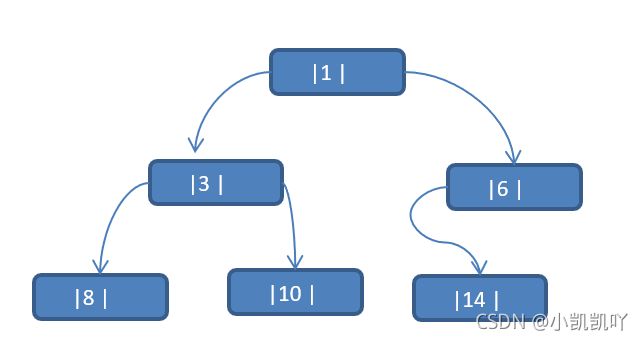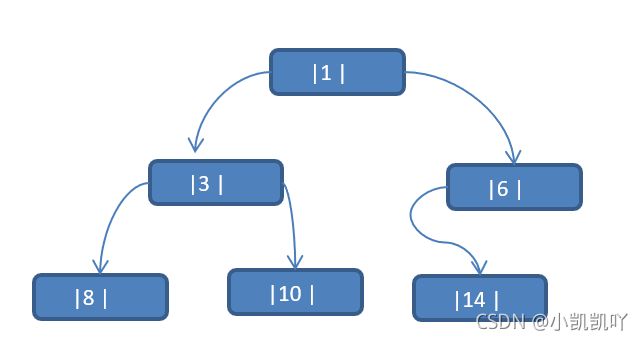Java实现线索化二叉树和遍历线索化二叉树
10.3 线索化二叉树
10.3.1 先看一个问题
将数列 {1, 3, 6, 8, 10, 14 } 构建成一颗二叉树. n+1=7
 问题分析:
问题分析:
- 当我们对上面的二叉树进行中序遍历时,数列为 {8, 3, 10, 1, 6, 14 }
- 但是 6, 8, 10, 14 这几个节点的 左右指针,并没有完全的利用上. 3) 如果我们希望充分的利用 各个节点的左右指针, 让各个节点可以指向自己的前后节点,怎么办?
- 解决方案-----线索二叉树
10.3.2 线索二叉树基本介绍
- n 个结点的二叉链表中含有 n+1 【公式 2n-(n-1)=n+1】 个空指针域。利用二叉链表中的空指针域,存放指向该结点在某种遍历次序下的前驱和后继结点的指针(这种附加的指针称为"线索")。
- 这种加上了线索的二叉链表称为线索链表,相应的二叉树称为线索二叉树(Threaded BinaryTree)。根据线索性质的不同,线索二叉树可分为前序线索二叉树、中序线索二叉树和后序线索二叉树三种。
- 一个结点的前一个结点,称为前驱结点。
- 一个结点的后一个结点,称为后继结点。
10.3.3 线索二叉树应用案例
应用案例说明:将下面的二叉树,进行中序线索二叉树。中序遍历的数列为 {8, 3, 10, 1, 14,6}

思路分析: 中序遍历的结果:{8, 3, 10, 1,14,6}

说明: 当线索化二叉树后,Node 节点的 属性 left 和 right ,有如下情况:
- left 指向的是左子树,也可能是指向的前驱节点. 比如 ① 节点 left 指向的左子树, 而 ⑩ 节点的 left 指向的就是前驱节点。
- right 指向的是右子树,也可能是指向后继节点,比如 ① 节点 right 指向的是右子树,而⑩ 节点的 right 指向的是后继节点。
10.3.4 遍历线索化二叉树
- 说明:对前面的中序线索化的二叉树, 进行遍历
- 分析:因为线索化后,各个结点指向有变化,因此原来的遍历方式不能使用,这时需要使用新的方式遍历线索化二叉树,各个节点可以通过线型方式遍历,因此无需使用递归方式,这样也提高了遍历的效率。 遍历的次序应当和中序遍历保持一致。
代码实现
/**
* @author zk
* @version 1.0.0
* @ClassName ThreadedBinaryTreeDemo.java
* @Description TODO 线索化二叉树
* @createTime 2021年09月26日 11:39:00
*/
public class ThreadedBinaryTreeDemo {
public static void main(String[] args) {
//测试一把中序线索二叉树的功能
HeroNode root = new HeroNode(1, "tom");
HeroNode node2 = new HeroNode(3, "jack");
HeroNode node3 = new HeroNode(6, "smith");
HeroNode node4 = new HeroNode(8,"mary");
HeroNode node5 = new HeroNode(10, "king");
HeroNode node6 = new HeroNode(14,"dim");
//二叉树,后面我们要递归创建, 现在简单处理使用手动创建
root.setLeft(node2);
root.setRight(node3);
node2.setLeft(node4);
node2.setRight(node5);
node3.setLeft(node6);
//测试中序线索化
ThreadedBinaryTree threadedBinaryTree = new ThreadedBinaryTree();
threadedBinaryTree.setRoot(root);
threadedBinaryTree.threadedNodes();
//测试: 以 10 号节点测试
HeroNode leftNode = node5.getLeft();
HeroNode rightNode = node5.getRight();
System.out.println("10 号结点的前驱结点是 =" + leftNode);
System.out.println("10 号结点的后继结点是=" + rightNode);
// System.out.println("遍历线索化二叉树的方法(基于中序线索二叉树)");
// threadedBinaryTree.threadList();
}
}
class ThreadedBinaryTree {
private HeroNode root;
//为了实现线索化,需要创建要给指向当前结点的前驱结点的指针
//在递归进行线索化时,pre 总是保留前一个结点
private HeroNode pre;
public HeroNode getRoot() {
return root;
}
public void setRoot(HeroNode root) {
this.root = root;
}
public void threadedNodes(){
this.threadedNodes(root);
}
// /遍历线索化二叉树的方法(基于中序线索二叉树)
public void threadList(){
HeroNode node = root;
while (node!=null){
while (node.getLeftType() ==0){
node = node.getLeft();
}
System.out.println(node);
while (node.getRightType()==1){
node = node.getRight();
System.out.println(node);
}
node = node.getRight();
}
}
// 编写对二叉树进行中序线索化的方法(前序线索化和后序线索化没写)
public void threadedNodes(HeroNode node){
if (node ==null){
return;
}
//(一)先线索化左子树
threadedNodes(node.getLeft());
//(二))线索化当前结点[有难度]
if (node.getLeft()==null){
node.setLeft(pre);
node.setLeftType(1);
}
if (pre !=null && pre.getRight()==null){
pre.setRight(node);
pre.setRightType(1);
}
//!!! 每处理一个结点后,让当前结点是下一个结点的前驱结点
pre = node;
// (三)线索化右子树
threadedNodes(node.getRight());
}
// 前序遍历
public void preOrder() {
if (this.root != null) {
this.root.preOrder();
} else {
System.out.println("root is null");
}
}
// 中序遍历
public void inOrder() {
if (this.root != null) {
this.root.inOrder();
} else {
System.out.println("root is null");
}
}
// 后序遍历
public void postOrder() {
if (this.root != null) {
this.root.postOrder();
} else {
System.out.println("root is null");
}
}
// 前序遍历查找
public HeroNode preOrderSearch(int id){
if (this.root != null){
return this.root.preOrderSearch(id);
}else {
return null;
}
}
// 中序遍历查找
public HeroNode inOrderSearch(int id){
if (this.root != null){
return this.root.inOrderSearch(id);
}else {
return null;
}
}
// 后序遍历查找
public HeroNode postOrderSearch(int id){
if (this.root != null){
return this.root.postOrderSearch(id);
}else {
return null;
}
}
// 根据id删除节点
// this.root = null;是本方法的缺陷,删除一个节点不应该把整个树清空
public void delNode(int id){
if (this.root !=null){
if (this.root.getId() == id){
this.root = null;
}else {
this.root.delNode(id);
}
}else {
System.out.println("root is null");
}
}
}
class HeroNode {
private int id;
private String name;
private HeroNode left;
private HeroNode right;
//说明
//1. 如果 leftType == 0 表示指向的是左子树, 如果 1 则表示指向前驱结点
//2. 如果 rightType == 0 表示指向是右子树, 如果 1 表示指向后继结点
private int leftType;
private int rightType;
public int getLeftType() {
return leftType;
}
public void setLeftType(int leftType) {
this.leftType = leftType;
}
public int getRightType() {
return rightType;
}
public void setRightType(int rightType) {
this.rightType = rightType;
}
public HeroNode(int id, String name) {
this.id = id;
this.name = name;
}
public int getId() {
return id;
}
public void setId(int id) {
this.id = id;
}
public String getName() {
return name;
}
public void setName(String name) {
this.name = name;
}
public HeroNode getLeft() {
return left;
}
public void setLeft(HeroNode left) {
this.left = left;
}
public HeroNode getRight() {
return right;
}
public void setRight(HeroNode right) {
this.right = right;
}
@Override
public String toString() {
return "HeroNode{" +
"id=" + id +
", name='" + name + '\'' +
'}';
}
// 前序遍历(preOrder traversal)
public void preOrder() {
System.out.println(this);
if (this.left != null) {
this.left.preOrder();
}
if (this.right != null) {
this.right.preOrder();
}
}
// 中序遍历(inOrder traversal)
public void inOrder() {
if (this.left != null) {
this.left.inOrder();
}
System.out.println(this);
if (this.right != null) {
this.right.inOrder();
}
}
// 后序遍历(postOrder traversal)
public void postOrder() {
if (this.left != null) {
this.left.postOrder();
}
if (this.right != null) {
this.right.postOrder();
}
System.out.println(this);
}
// 前序遍历查找
public HeroNode preOrderSearch(int id) {
System.out.println("进入前序遍历查找进行比对");
if (this.id == id) {
return this;
}
HeroNode resNode = null;
if (this.left != null) {
resNode = this.left.preOrderSearch(id);
}
if (resNode != null) {
return resNode;
}
if (this.right != null) {
resNode = this.right.preOrderSearch(id);
}
return resNode;
}
// 中序遍历查找
public HeroNode inOrderSearch(int id) {
HeroNode resNode = null;
if (this.left != null) {
resNode = this.left.inOrderSearch(id);
}
if (resNode != null) {
return resNode;
}
System.out.println("进入中序遍历查找进行比对");
if (this.id == id) {
return this;
}
if (this.right != null) {
resNode = this.right.inOrderSearch(id);
}
return resNode;
}
// 后序遍历查找
public HeroNode postOrderSearch(int id) {
HeroNode resNode = null;
if (this.left != null) {
resNode = this.left.postOrderSearch(id);
}
if (resNode != null) {
return resNode;
}
if (this.right != null) {
resNode = this.right.postOrderSearch(id);
}
if (resNode !=null){
return resNode;
}
System.out.println("进入后序遍历查找进行比对");
if (this.id == id) {
return this;
}
return null;
}
// 递归删除节点
/**
* 1) 如果删除的节点是叶子节点,则删除该节点
* 2) 如果删除的节点是非叶子节点,则删除该子树.(本方法的缺陷,不应该删除子树)
* 3)测试,删除掉 5 号叶子节点 和 3 号子树.
* 4) 完成删除思路分
**/
// 思路
/**
* 1. 因为我们的二叉树是单向的,所以我们是判断当前结点的子结点是否需要删除结点,而不能去判断当前这个结点是不是需要删除结点.
* 2. 如果当前结点的左子结点不为空,并且左子结点 就是要删除结点,就将 this.left = null; 并且就返回(结束递归删除)
* 3. 如果当前结点的右子结点不为空,并且右子结点 就是要删除结点,就将 this.right= null ;并且就返回(结束递归删除)
* 4. 如果第 2 和第 3 步没有删除结点,那么我们就需要向左子树进行递归删除
* 5. 如果第 4 步也没有删除结点,则应当向右子树进行递归删除.
**/
public void delNode(int id){
// 1.如果当前结点的左子结点不为空,并且左子结点 就是要删除结点,就将 this.left = null; 并且就返回(结束递归删除)
if (this.left != null&& this.left.getId() == id){
this.left = null;
return;
}
// 2.如果当前结点的右子结点不为空,并且右子结点 就是要删除结点,就将 this.right= null ;并且就返回(结束递归删除)
if (this.right != null&& this.right.getId() == id){
this.right = null;
return;
}
// 3.如果第 2 和第 3 步没有删除结点,那么我们就需要向左子树进行递归删除
if (this.left != null){
this.left.delNode(id);
}
// 4.如果第 4 步也没有删除结点,则应当向右子树进行递归删除.(正规点的话 要判断第三步是否删除成功,然后在确定下面是否执行)
if (this.right != null){
this.right.delNode(id);
}
}
}